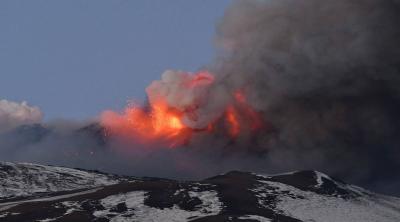A cloud of smoke emerged, along with flames and ash, following an explosion on the southeastern side of Mount Etna located on the island of Sicily in southern Italy.
Italian media reported today that lava flows reached heights of 2,000 meters, causing temporary closure of the airport in Catania due to ash dispersion. The media also noted that a column of smoke and ash rose into the air for a distance of one kilometer, making flying unsafe and leading to ash falling on homes, streets, and balconies throughout the city. Local media users and social media shared images and videos of the event, showing a massive cloud of smoke rising from the volcano's crater and lava flowing down the slope. There were no reports of injuries or damage.
The eruption of Etna, which stands at 3,300 meters, is not unusual. The volcano, located in eastern Sicily, is a UNESCO World Heritage Site. It is important to note that Etna is an active volcano on the eastern coast of Sicily, near Messina and Catania. It is currently one of the largest active volcanoes in Europe, rising approximately 3,326 meters (10,910 feet), and this height varies with eruptions; it is now 21.6 meters lower than it was in 1865. It is the highest mountain in Italy south of the Alps, covering an area of 1,190 square kilometers (460 square miles) with a base perimeter of 140 kilometers. This makes it the largest of the three active volcanoes in Italy, rising almost three times higher than the second highest mountain, Mount Vesuvius.
Mount Etna is one of the most active volcanoes in the world, almost continuously erupting. While it can be very destructive at times, it is generally not considered extremely hazardous, with thousands of people living on its slopes and surrounding areas. The fertile volcanic soil supports agricultural expansion, with vineyards and orchards spread across the foothills and the extensive plains of Catania to the south. Due to its recent active history and proximity to populated areas, it has been classified by the United Nations as a 'conical volcano.' In July 2019, lava flowing from the volcano reached significant heights, reaching 1.5 kilometers from the vent. This led the police to implement safety measures, which included closing two airports in the city of Catania, the closest areas to the volcano's activity.




